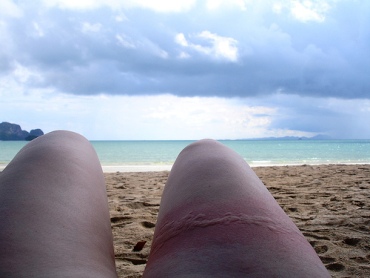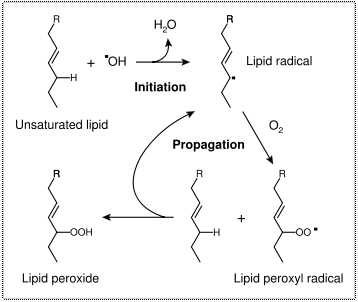Modifications
Structure
To understand and appreciate the adaptations of
the Lion's Mane jellyfish, you must first learn about its morphology. All
Cnidarians are diploblastic which means they have two primary
germ layers: the ectoderm and endoderm. This includes tissue
associated with the gut and associated glands. The ectoderm, on the
other hand, gives rise to the epidermis and the nervous tissue.
Also, all Cnidarians (including the Lion's Mane) present radial
symmetry. This allows for animals to reach out in all
directions from one center such as during feeding. Those are
some adaptations it shares with its close relatives, lets get into
some more unique characteristics of the Lion's Mane. Cyanea capillata have 8 lobes that are very obvious to the
naked eye. Visit the Pictures page
to get a better look of the Lion's Mane's lobes. A few lobes have organs used for sensing things
such as odor and
balance. However, a more interesting adaptation they
have is a primitive light receptor
located at the ends of selected lobes! There is a single
primitive
opening that serves as the mouth and anus. When in the medusa
stage, the jellyfish adapted to having radial canals to
distribute nutrients to their tentacles faster. Recognize that
the image on the right is that of a general jellyfish and some
structures are not found in Cyanea capillata such as
the velum. For a better view of the words and what structure
they are referring to just click on the picture! Cyanea
capillata can propel itself because of special muscles
called coronal muscles, embedded on the underside of the bell, which
push water out of the hollow bell. As water is pushed in one
direction, the jellyfish moves in the counter direction. The
Lion's Mane does not have a brain or eyes so it relies on nerve
cells to sense and react to food or danger. Sensing organs
tell them whether they are heading up or down, into the light or
away from it. Even with such a basic structure, they are
amazing hunters! Check out the
Nutrition page to see what they eat!
Color
 The smaller Lion's Mane jellyfish ranges from a
milky white color to a mustard yellow. This is compared to the
larger jellyfish who vary in color from a deep brick red to a dark purple.
The change in coloration is manly due to the depth at which it
lives. Some believe that the certain colors help the jellyfish capture
various prey. You can see more of the Cyanea capillata's
beautiful colors on my Pictures page!
If you want to check out another colorful organism, check out
Hapalochlaena lunulata (the blue-ringed octopus).
The smaller Lion's Mane jellyfish ranges from a
milky white color to a mustard yellow. This is compared to the
larger jellyfish who vary in color from a deep brick red to a dark purple.
The change in coloration is manly due to the depth at which it
lives. Some believe that the certain colors help the jellyfish capture
various prey. You can see more of the Cyanea capillata's
beautiful colors on my Pictures page!
If you want to check out another colorful organism, check out
Hapalochlaena lunulata (the blue-ringed octopus).
Venom
 The
Lion's Mane jellyfish is known not only for its giant
structure but also for its painful stings. The
stinging sensation, more commonly referred to as a burning
sensation, when referring to Cyanea capillata,
originates in the jellyfish's cnidocyte. Cnidocytes
are found in all Cnidarians and is one of the
characteristics that separates Cnidarians from Ctenophores.
Each individual cnidocyte contains a threadlike tube lined
with a series of barbed spine called a nematocyst (also
known as cnidocyst). The cnidocyte is activated by a
hair-like structure cnidocil sticking out of the nematocyst.
Once triggered it allows water to flow down its
concentration gradient into the nematocyst which has an
extremely high osmotic pressure. This high osmotic
pressure inside the nematocyst causes the inflow of water to
be very forceful thus
The
Lion's Mane jellyfish is known not only for its giant
structure but also for its painful stings. The
stinging sensation, more commonly referred to as a burning
sensation, when referring to Cyanea capillata,
originates in the jellyfish's cnidocyte. Cnidocytes
are found in all Cnidarians and is one of the
characteristics that separates Cnidarians from Ctenophores.
Each individual cnidocyte contains a threadlike tube lined
with a series of barbed spine called a nematocyst (also
known as cnidocyst). The cnidocyte is activated by a
hair-like structure cnidocil sticking out of the nematocyst.
Once triggered it allows water to flow down its
concentration gradient into the nematocyst which has an
extremely high osmotic pressure. This high osmotic
pressure inside the nematocyst causes the inflow of water to
be very forceful thus  propelling the nematocyst with great
force out of the cnidocyte and into the prey. Cyanea
capillata have three different types of nematocysts,
all of which are very similar and are triggered relatively
at the same rate. A Lion's Mane jellyfish
can have up to 8 clusters of 150 tentacles, that is
approximately 1,200 tentacles per jellyfish. A
Cyanea capillata's tentacle has been recorded of being
nearly 200 feet in length. If these staggering numbers
are not scaring you enough, every single one of these
enormous tentacles are lined with a ridiculous amount of
cnidocytes that are ready to be triggered any time they are
touched. To learn how listening to your parents can
help prevent a painful encounter with a Lion's Mane, visit my
Interactions page!
propelling the nematocyst with great
force out of the cnidocyte and into the prey. Cyanea
capillata have three different types of nematocysts,
all of which are very similar and are triggered relatively
at the same rate. A Lion's Mane jellyfish
can have up to 8 clusters of 150 tentacles, that is
approximately 1,200 tentacles per jellyfish. A
Cyanea capillata's tentacle has been recorded of being
nearly 200 feet in length. If these staggering numbers
are not scaring you enough, every single one of these
enormous tentacles are lined with a ridiculous amount of
cnidocytes that are ready to be triggered any time they are
touched. To learn how listening to your parents can
help prevent a painful encounter with a Lion's Mane, visit my
Interactions page!
This image demonstrates the triggering of a nematocyst out of a cnidocyte.
More Venom
 Cyanea capillata's venom consist
of various toxins such as neurotoxins that paralyze prey
immediately. One action of neurotoxins on its prey is the
blockage of voltage-gated sodium (Na-v) channels. The
venom in the Lion's Mane also causes
hemolysis (breakdown or destruction of red blood cells).
This is caused by pore-formation and lipid
peroxidation. Lipid peroxidation is the process
in which free radicals take electrons from the lipids in the
cell membranes, this causes a great amount of damage to the
cell. This process is demonstrated on the image to the
right of this text. Studies on scyphozoans in
reference to venom composition and toxic effects are rare as
of now. One study has isolated the novel cytotoxic
protein (CcTX-1). This protein is closely related to
two cubozoan species, Carybdea alata (CaTX-1) and
Carybdea rastonii (CrTX-1). If you are
interested in this venom you should check out the even more
intense venom of
Enhydrina schistosa (one of the most
venomous snakes in the world).
Cyanea capillata's venom consist
of various toxins such as neurotoxins that paralyze prey
immediately. One action of neurotoxins on its prey is the
blockage of voltage-gated sodium (Na-v) channels. The
venom in the Lion's Mane also causes
hemolysis (breakdown or destruction of red blood cells).
This is caused by pore-formation and lipid
peroxidation. Lipid peroxidation is the process
in which free radicals take electrons from the lipids in the
cell membranes, this causes a great amount of damage to the
cell. This process is demonstrated on the image to the
right of this text. Studies on scyphozoans in
reference to venom composition and toxic effects are rare as
of now. One study has isolated the novel cytotoxic
protein (CcTX-1). This protein is closely related to
two cubozoan species, Carybdea alata (CaTX-1) and
Carybdea rastonii (CrTX-1). If you are
interested in this venom you should check out the even more
intense venom of
Enhydrina schistosa (one of the most
venomous snakes in the world).
Are you lost? Go back to my Home Page!